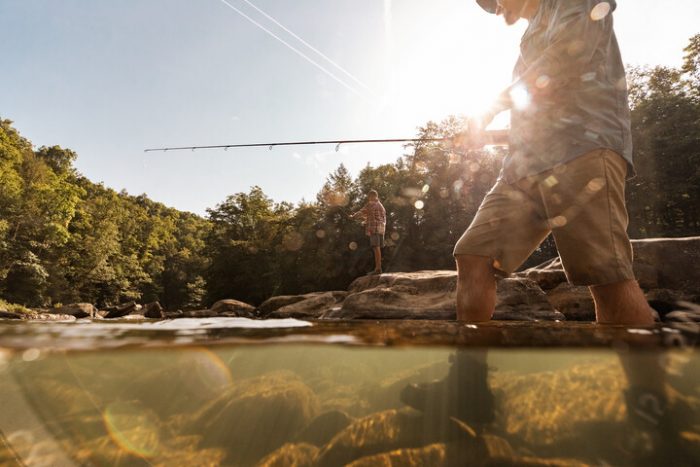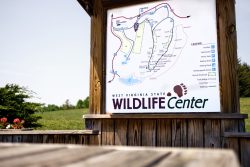Our goal as the Division of Natural Resources is to protect and preserve wildlife and wildlife habitat for future generations. We encourage people to get outdoors while admiring what nature has to offer. However, we encourage everyone to watch and learn and leave wildlife wild.
The Seven Principles of Leave No Trace
Plan Ahead and Prepare
Plan for your trip. Gather information on where you are going ahead of time. Gather maps of the area and trails, prepare for all types of weather and dress accordingly. Make sure that you have a bag packed with a first-aid kit, any medicines that are needed by anyone in the group, and a charged cell phone. If you’re staying overnight, make sure you bring adequate camp gear (tent, fire starter, sleeping bag/pad, extra clothes, etc.) and enough food for everyone on the trip. Please make sure to consider all terrain types that you may encounter and prepare ahead of time. Make sure that you check the area that you are visiting for any regulations or overnight permits that you might need.
Travel and Camp on Durable Surfaces
When you’re traveling through a wildlife habitat, you are in their home. Our goal is to minimize any damage that we could cause from overuse. When you travel, make sure that you travel along trails or paved walkways. This limits the amount of off-trail use that could damage certain wildlife habitat. It also keeps human impact to a minimized area where parks can appropriately accommodate this impact. If you are backpacking through a wilderness and looking for a bathroom, or overlook please make sure people take separate routes to the destination to keep the area as natural as possible.
When setting up a campsite, make sure that you pitch your tent on durable surfaces. Areas that are best spots for setting up your camp will be areas that you will do the least amount of damage. This means little vegetation is key, stay away from camping on water sources and if possible choose an area that has already been set up for setting up a tent.
Dispose of Waste Properly
Dispose of all trash in designated areas or pack it out. If you see trash along the way it is always nice to bring out more trash with you then you came in with. To dispose of human waste make sure that you choose a location that is 200 feet from any water source, and dig a hole 6-8 inches deep, 4-6 inches wide and dispose of any toilet paper in the hole (or pack it out) and then cover the hole once finished.
Leave What You Find
Leave what you find. Don’t take any vegetation, rocks, wildlife. Our goal is to leave it as natural as when you arrived. Make sure that you never transport anything you find in nature due to invasive species. Make sure never to transport firewood for this exact reason.
Minimize Campfire Impacts
Minimize campfire impacts by only using dead and down wood that you find in the area. Use a camp stove when possible instead of a fire. Also, be aware of any fire bans or regulations that might be in effect in your area. Try to use existing fire rings when available and ALWAYS make sure your fire is out before going to bed or leaving the area.
Respect Wildlife
This is their home. Respect their home. Don’t yell or be loud or make a lot of quick movements. Never get close to wildlife, but instead snap a few pictures from afar. Some animals carry diseases that might not be obvious to the public. If you happen to see a sick or injured animal, mark the location and get in contact with a park ranger or natural resources officer.
Be Considerate of Other Visitors
As you respect wildlife, also respect other visitors. Be considerate of others by moving to the side when others pass by (know who has the right of way), pick up after yourself, don’t be loud, leash your pets and pick up after them (if they are permitted in the area).
Warmwater Hatchery Program
The Division of Natural Resources seeks to provide a variety of angling opportunities to meet increasing demands on our recreational fisheries, while also conserving and protecting this vital resource. One way that the DNR addresses this need is through its fish hatchery programs. Many anglers are aware of the successful trout hatchery and stocking program that provides and enhances fishing in small impoundments and streams statewide. The state’s warmwater hatchery and stocking program, although a little less well known, is extremely significant to all West Virginia anglers.
West Virginia’s warmwater hatchery program has been instrumental in providing fishing opportunities to anglers for nearly 60 years. For most of that time, the Palestine Hatchery was the state’s primary facility dedicated to the production of warmwater species. Millions of walleye, musky, tiger musky, channel catfish, hybrid striped bass, saugeye, sunfish, and largemouth and smallmouth bass have been raised over the years at Palestine Hatchery, and stocked into streams and lakes across the state. Consequently, the Palestine Hatchery has been a key to most of West Virginia’s fishery management successes.
A recent addition to the hatchery program, the Apple Grove Hatchery in Mason County, will further enhance the DNR’s fish production capabilities providing increased angling opportunities to West Virginia’s anglers. This new facility has 34 ponds totaling 43 acres and a 5-acre water supply reservoir that nearly doubles the DNR’s fish production capabilities. A modern, 9,300 square-foot hatchery building will further improve fish production efforts enhancing the DNR’s ability to spawn, rear, and ultimately stock fish into West Virginia’s waters. Musky, tiger musky, walleye, channel catfish, and other species will be raised at Apple Grove Hatchery.
The Apple Grove and Palestine hatcheries are vital to the DNR’s ability to provide fish for recreational angling and restoration efforts throughout West Virginia. These facilities in conjunction with modern and science-based fishery management efforts conducted by the DNR’s staff fishery biologists will be key to enhancing the state’s recreational fisheries for the enjoyment of all.
Additional Resources
State Wildlife Action Plans Preventing Wildlife from Becoming Endangered
Partners in Conservation
West Virginia Wild Yards Program
Many people provide habitat for wildlife around their homes without realizing it. Bird feeders, fruiting plants, and water sources attract wildlife into our yards, fulfilling their needs and providing us with hours of enjoyment. Studies show gardening and spending time outdoors is good for you. Landscapes filled with native plants help improve our quality of life and make our spaces more pleasant and enjoyable to live in, for us and for wildlife. Sharing space with wildlife and landscaping with their habitat needs in mind can be an enjoyable and inexpensive pastime.
The Wildlife Diversity Program (WDP) of the West Virginia Division of Natural Resources has developed the Wild Yards Program to recognize the efforts of backyard landscapers to create and maintain wildlife habitat. Approved properties will be entered into a registry of certified Wild Yards kept by the WDP. The applicant will receive a certificate and a sign that can be placed in the backyard habitat to let everyone know that the area is part of a statewide network of WV Wild Yards.
Why go wild? A diverse wild yard requires much less maintenance than a traditionally landscaped yard. Once established, native plants don’t require additional watering, chemical fertilizers or pesticides because they are adapted to local conditions and local insect pests. Those native insects are also important food for other wildlife. Landscaping with native plants can also save you money. Using plants native to your area in your yard can reduce outdoor water use by 20 to 50 percent. You can reduce your heating and cooling costs by planting native shrubs to shade your air conditioning unit, or by planting native deciduous trees on the south and west sides of your house. Trees that grow tall enough to shade the roof from afternoon sun can lower indoor air temperatures by up to 10 degrees F, and when the trees drop their leaves in the winter, they can let the winter sunlight warm your home. Growing less turf grass lawn and more native plants also helps to reduce the air pollution from exhaust and noise pollution from noisy lawn mowers and leaf blowers. Leaving the leaves in the fall provides habitat for many species that use the leaf litter for food or shelter, and the leaf litter also suppresses weeds and naturally fertilizes the soil as it breaks down. These are just a few benefits to landscaping with wildlife in mind.
How do you attract wildlife to your yard? Focus on providing the four necessary components all wildlife need: food, water, cover, and places to raise young. You can start small by providing feeders, birdbaths, and nest boxes for a few backyard songbirds, or dream big and restore a native meadow for dozens of species. Whether you live on a quarter-acre suburban lot, a five-acre townhouse development, or in a city apartment, you can provide habitat for wildlife. You can start right away by filling a new birdfeeder with sunflower seeds, hanging a nest box, or planting milkweed for butterflies.
If you have questions about the WV Wild Yards program or want to learn more about how to improve wildlife habitat in your yard, contact:
DNRWildYards@wv.gov
(304) 637-0245
West Virginia Wild Yards, Wildlife Diversity Program, WVDNR,
P.O. Box 67, Elkins, WV 26241
How to Apply:
The Wild Yards Manual has information and guidelines on how to provide the necessary habitat components for wildlife. Read the online manual or contact the Wild Yards Program to receive a paper copy, and then fill out a Wild Yards application once you believe your yard meets the needs of wildlife.
Download the Wild Yards Manual
Individual Wild Yards Manual Chapters:
References and Printed Materials
Other Resources:
WV Native Plant Selection Tool



